The Amish Buggy (All About Plain Transportation)
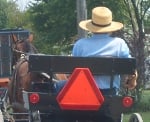 The horse-drawn buggy is essential to Amish society. Amish buggies are both practical transport, and symbolic of the people.
The horse-drawn buggy is essential to Amish society. Amish buggies are both practical transport, and symbolic of the people.
Though most Amish allow riding in motor vehicles such as cars and buses, no Amish permit ownership of the automobile. Amish feel the horse-drawn carriage promotes a slower pace of life and greater reliance on community.
Amish buggies are not all alike. Different designs designate specific communities and groups. Amish carriages come in a range of colors, styles, and feature varying degrees of technology.
The horse-and-buggy is a key part of Amish identity and culture. I once asked an Amish minister what are the crucial elements when it comes to whether he considers a given religious group “Amish”. Use of the horse-and-carriage was the first thing he named.
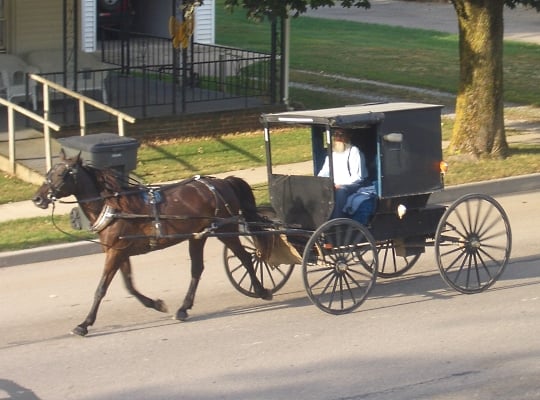
Old Order Mennonites, Anabaptist cousins of the Amish, depend on the buggy as well. Old Order Mennonite buggies typically differ from Amish vehicles in design.
In places where Amish and Mennonites live side-by-side, you’ll see different carriage styles on the road. For instance, in Lancaster County, PA, Amish drive grey-topped buggies, while Old Order Mennonite carriages are black.
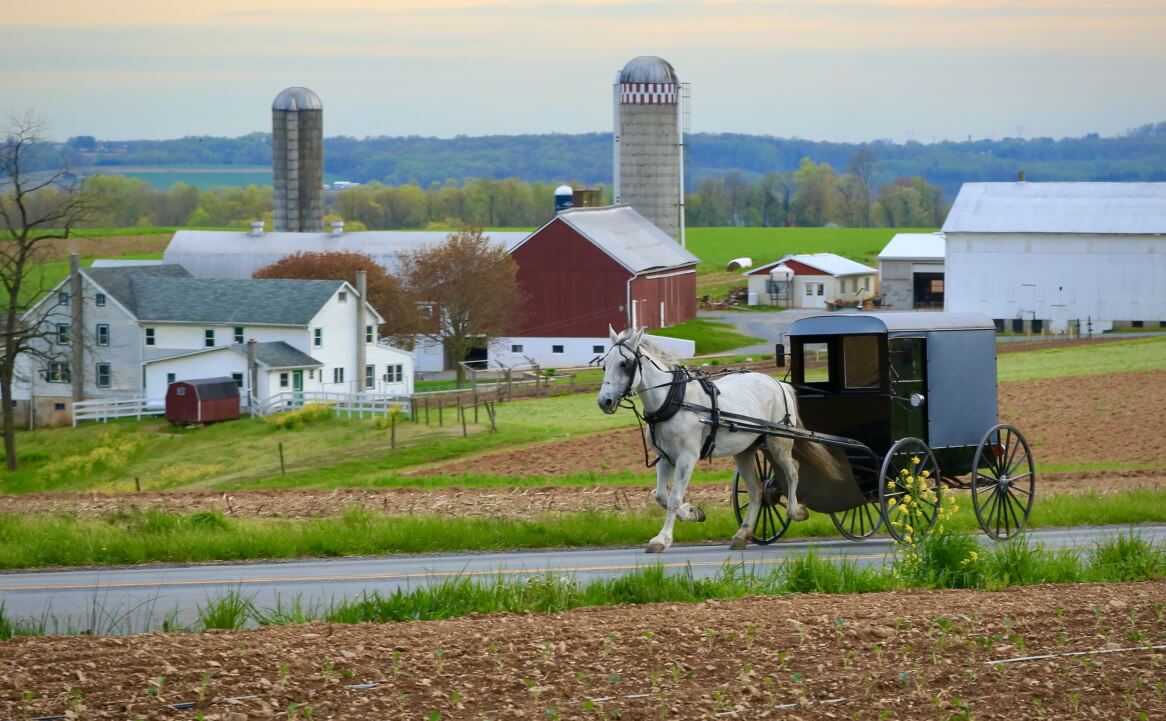
Below, we take a look at Amish buggies and other forms of horse-drawn transportation, including numerous photos from Amish communities in Pennsylvania and the Midwest.
Topics:
- Amish buggy styles–Amish vehicles come in many forms
- Mennonite buggies–Old Order Mennonites share much in common with Amish, including transport
- Swiss buggies–The Swiss Amish, most prevalent in Indiana, use only open carriages
- Buggy safety–Accidents happen too often. How Amish try to prevent them
- “Rare” Amish buggies–Uncommon designs and styles
- The buggy shop–Where Amish buggies come from
- The pony cart–“Buggy training” for youngsters?
- Buggy rides–The tourist side of Amish transport
Amish buggy styles and designs
Amish buggies come in many different designs and styles. Some examples from Amish settlements around the country:
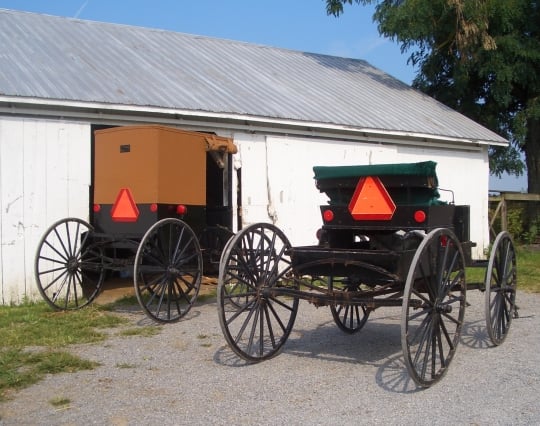
When we think of Pennsylvania Amish, we typically think of the Lancaster County gray buggy. The Amish at New Wilmington, Pennsylvania use a distinctive brown-topped vehicle. New Wilmington Amish and their spin-off groups are the only ones to use this color.
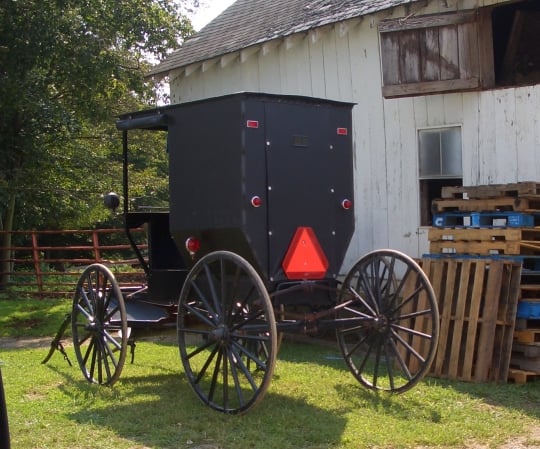
Other Amish in Pennsylvania drive a black style more like those associated with the Midwest. In Plain Buggies, Stephen Scott notes that the type common today in Ohio may have in fact originated in Pennsylvania (the Amish at Somerset County, PA, one of the oldest communities, use a similar style).
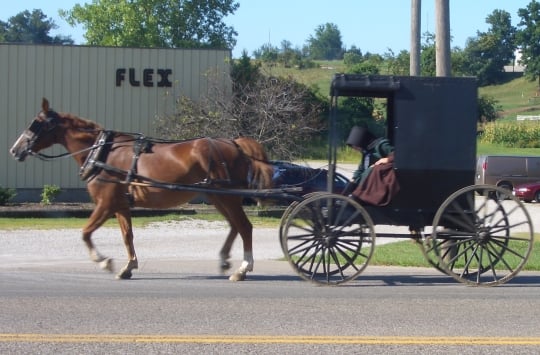
Amish in Holmes County, Ohio also drive a black buggy with angled-in sides. Holmes County buggies vary due to the many Amish groups inhabiting the area. If you see one without a Slow Moving Vehicle triangle, it most likely belongs to a member of a Swartzentruber Amish church.
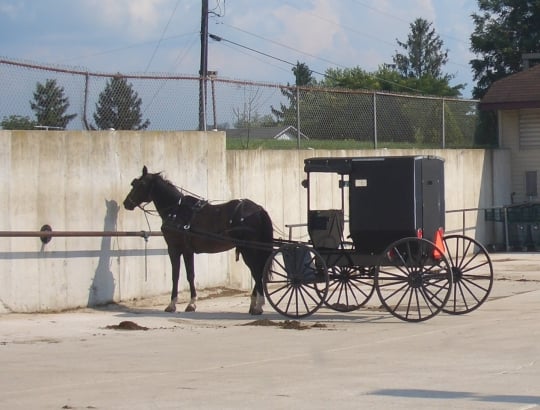
Businesses in Amish areas–from mom-and-pop stores to McDonald’s and Wal-Mart–provide buggy parking areas and hitching posts, such as the one above in Berlin, Ohio.
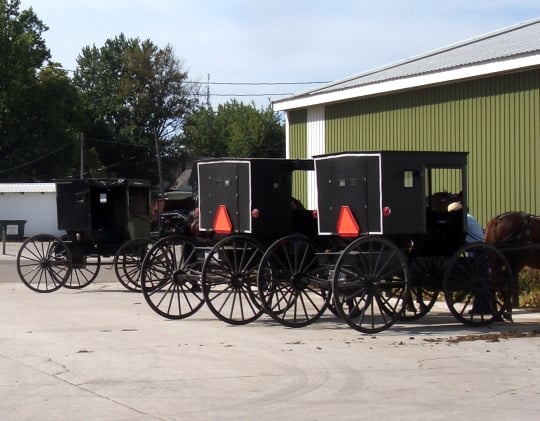
In the large northern Indiana community of Elkhart and Lagrange Counties, Amish buggies have a distinct squared-off boxy back.
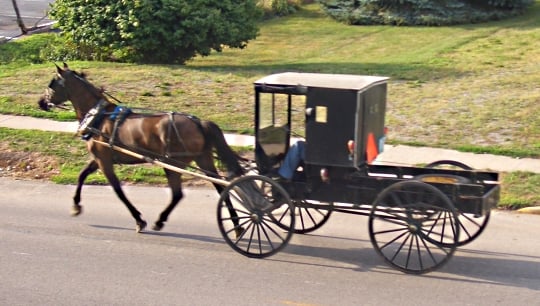
Buggies come in a variety of styles and designs, with different names depending on the community. The vehicle above, which we might think of as an “Amish pick-up truck”, is designed for hauling bulky items. Larger two-seater buggies are used for family trips and traveling to church on Sundays.
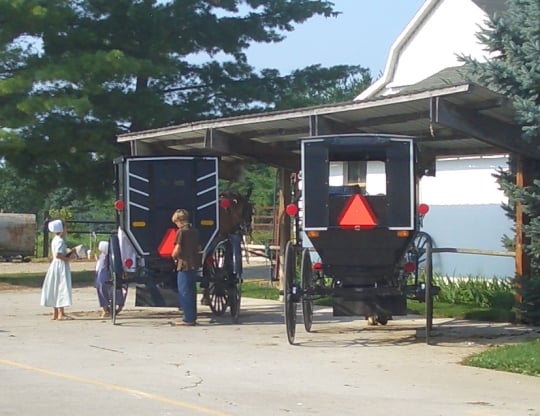
In addition to the buggy, Amish use a variety of transportation, including bicycles, scooters, and their own two feet. Buggies, of course, require basic maintenance, not to mention care of the horse. While they are not as convenient, buggies are useful for longer trips, journeys with small children, and visits to the store.
Mennonite buggies
Near the large Amish community at Nappanee, Indiana, you’ll find a small enclave of Old Order Mennonites. Mennonite buggies here can be distinguished by their boxier shape.
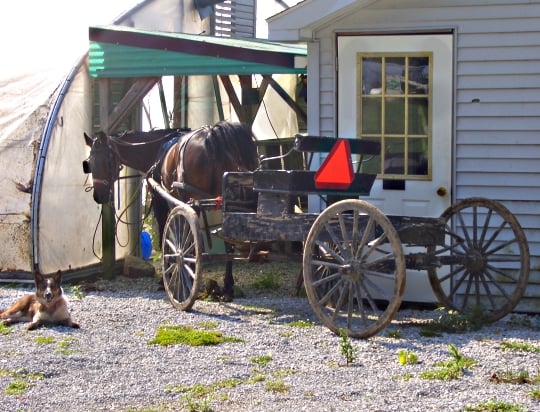
Above, a light Mennonite carriage for zipping around the neighborhood. Old Order Mennonite communities can be found in Virginia, Pennsylvania, Ontario, and other places.
“Topless” Swiss Amish buggies
Amish in certain so-called “Swiss” communities use a distinct style of buggy. Swiss carriages are always open-top.
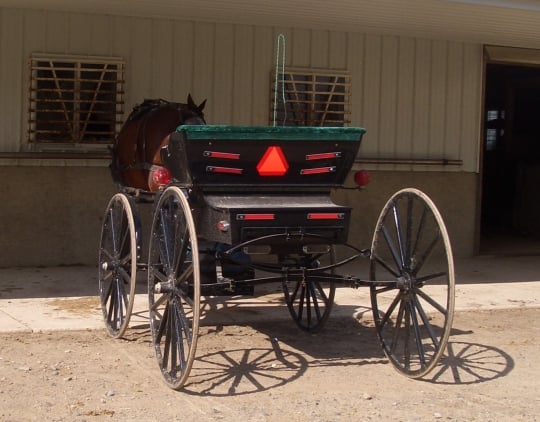
Amish travel in these carriages no matter the conditions. Bring your blanket, and an umbrella–no telling what the weather will be.
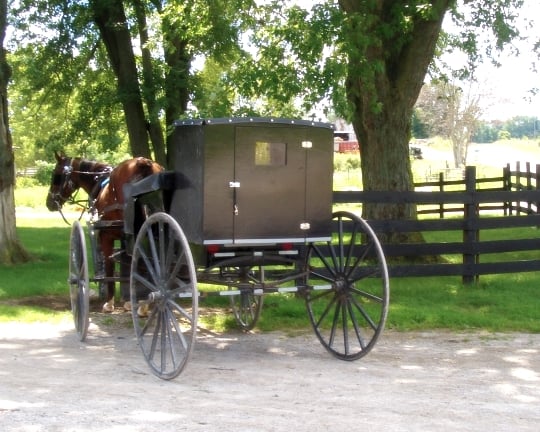
The above carriage was shot in the Swiss Amish settlement in Steuben County, Indiana. The container in back is known as the “kid box”–a protected compartment where small children can ride during bad weather.
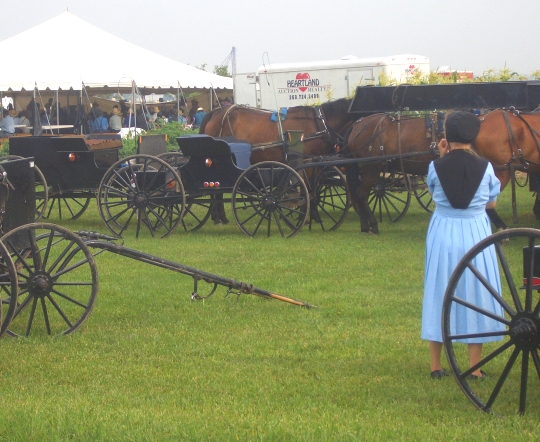
The two largest communities where you’ll find Amish who drive open buggies are in Adams and Allen counties in Indiana. Not a top to be seen.
Buggy lighting and road safety
Buggy safety is a big concern for Amish drivers. At night, Amish buggies rely on lighting and reflectors. Some are very brightly lit, showing up better than cars.
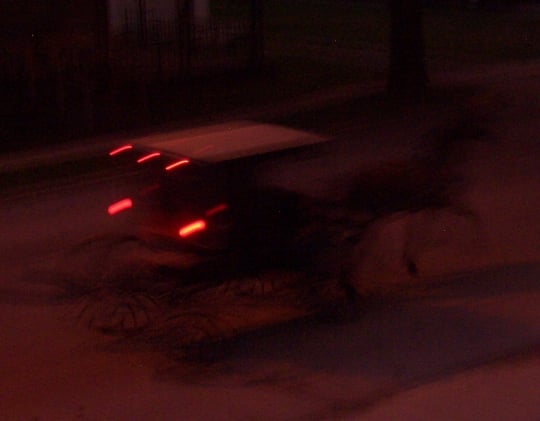
Other Amish groups do not use artificial lighting whatsoever, relying on lanterns and minimal reflector tape.
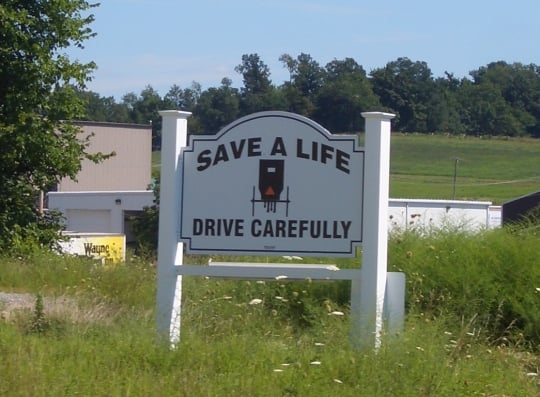
Amish buggies are frequently victims of road accidents. Crashes happen more often at night, and in many cases involve drivers under the influence. Amish are often killed or seriously hurt, as are their horses, which may have to be put down after accidents.
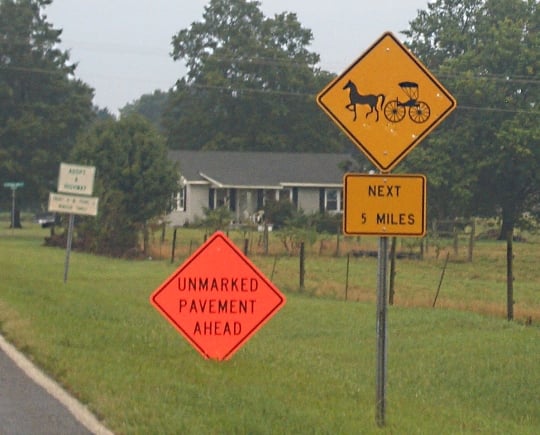
Buggy visibility is also an issue. Buggy signs warn of the presence of Amish on the road.
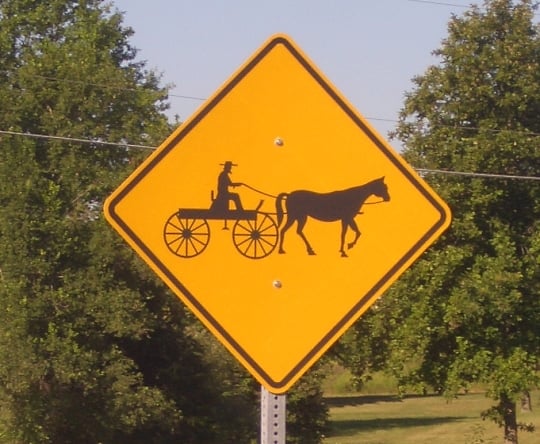
Amish who use little lighting or reflectorization may limit road time at night.
“Rare” Amish buggies
Tucked away in off-the-beaten path communities, you find less common Amish buggy styles. These buggies may feature a different body design, uncommon color, or unique use of reflectors.
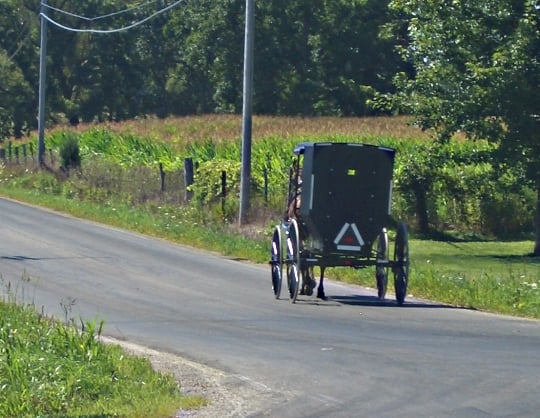
The buggy above is from the Amish community at Ashland County, Ohio. The Ashland Amish use grey reflector tape to outline a safety triangle. An orange reflector is located in the center of the tape triangle.
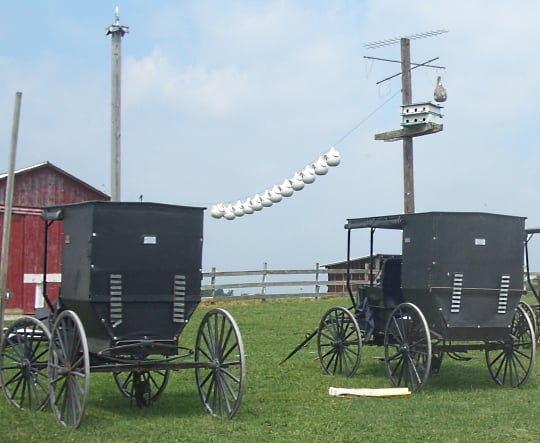
These buggies are found in the Hardin County, Ohio community. This group previously did not use the SMV insignia, before adopting the distinct two rows of reflectorized bars seen in the photo here.
Most Amish would find this display unusual, but to one Hardin County Amish woman I spoke with–just a toddler at the time of the change–the local reflectors seem perfectly normal. This design fulfills the requirement that the buggy show 72 square inches of reflectorization.
In addition to these, other less common buggy styles include the bright yellow Byler Amish buggy, found in Big Valley, Pennsylvania, the bulky Dover, Delaware Amish buggy, and the white-top Nebraska Amish buggy.
The buggy shop
In most Amish communities of size, you will find at least one buggy shop. Amish buggy makers handcraft their vehicles. While wood construction was once common, today’s buggies are more often made of fiberglass.
They also employ a good deal of technology, including drum brakes and even alternators, used to charge the on-board battery found on most Amish buggies.
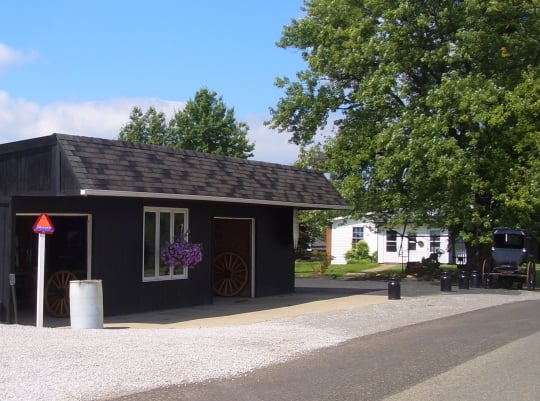
Amish buggy shops provide a crucial service for their communities. In Amish settlements without a buggy shop, Amish typically order their vehicles from larger communities. Amish also buy and sell used buggies at auction. A used Amish carriage may often be had for half the price of a new one, or less.
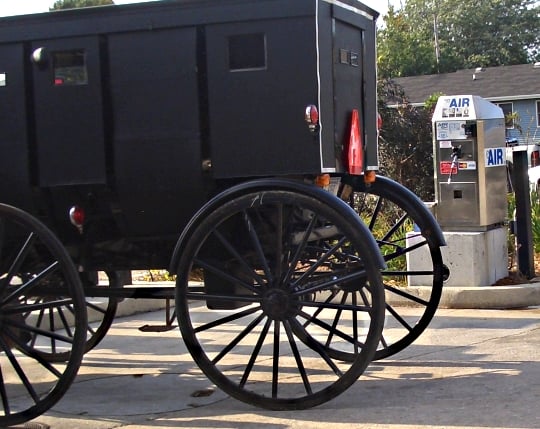
Amish buggy wheels and other parts are often built off-site and assembled at the buggy shop. When ordering a carriage, a customer typically has a wide range of options to choose from, including interior upholstery, lighting, style of “dashboard”, and so on.
Buggy windows may vary in style, with some featuring a back window and others not. Some buggies enable passengers to enter through a sliding door, while others use roll-up curtains.
Buggy wheels may be metal or rubber-rimmed. An Amishman I spoke with wondered why his church would not permit the rubber rims, as they eliminate noise when traveling on asphalt or gravel roads. Rubber makes a quieter and easier ride.
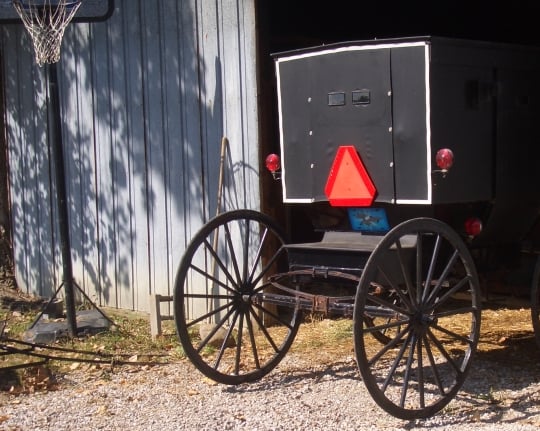
Some Amish youth further customize their buggies with interior and exterior decorations, and even music systems. Amish youth typically get their first buggies at age 16.
Buggies are essential for Amish boys of courting age, as the traditional Amish first date consists of a boy asking to drive a girl home from the weekly Sunday evening singing. Some adult-supervised Amish youth groups require their youth to drive open-top buggies.
Other types of horse-and-buggy transportation
In addition to the buggy, Amish use a number of other vehicles drawn by horses. Some are multi-purpose, while others fulfill a specific function.
Pony cart
Popular among Amish children and youth is the pony cart, a sort of “training” buggy. Pony carts are powered either by ponies or miniature horses. Amish children (especially in more progressive settlements) can often be seen zipping around front yards or traveling down country roads in these carts, pulled by feisty little beasts.
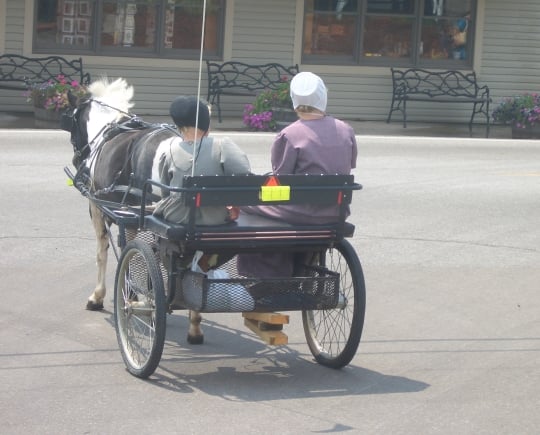
Amish adults sometimes ride in pony carts as well. Since no driver’s license is required, sometimes very young Amish children pilot pony carts.
The church wagon
If you visit an Amish community you may notice an oversized wagon that looks something like an Amish SUV.
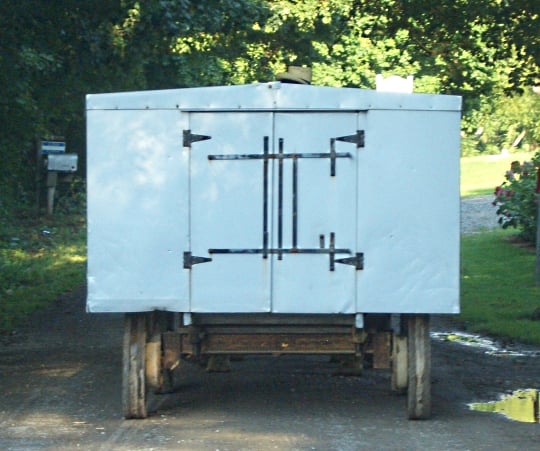
This large wagon is used to transport church benches between Amish homes. Amish do not hold church services in separate buildings, but rather in the basement, shop, or barn of a member’s home. Church is a movable event, and the passing church wagon points the way to where the next bimonthly service will be held.
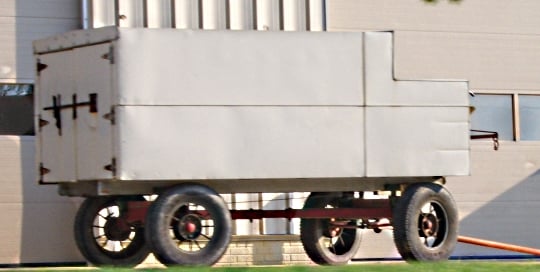
The church wagon also contains the Ausbund hymnals which Amish sing from during worship.
Horse-drawn machinery
In addition to buggies, carts, and wagons, Amish employ a variety of other horse-drawn implements. Many are used for farm work.
Manufacturers produce a wide range of horse-drawn equipment for both Amish and non-Amish customers. Amish-owned Pioneer Equipment in Wayne County, Ohio is one of the largest such producers in America.
Buggy rides
An article on Amish buggies wouldn’t be complete without a word on buggy rides. Tourists are often drawn to the idea of a jaunt in an Amish buggy. Amish buggy ride companies typically operate from tourist towns such as Berlin, Ohio, Intercourse, Pennsylvania, or Shipshewana, Indiana, each located in the heart of a large Amish community.
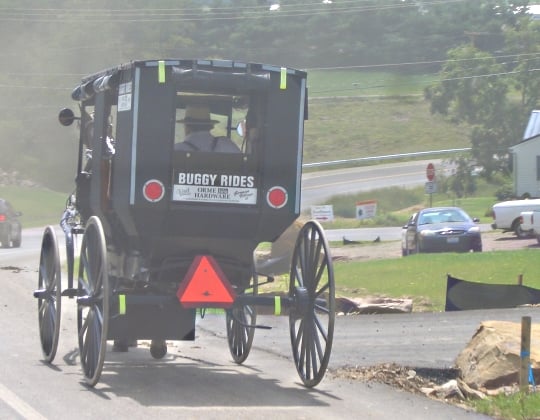
Tour buggies are often operated by Amish drivers (though not always) and may make stops at Amish homes, farms, and businesses. Drivers are knowledgeable about Amish customs and culture, and offer riders background information on the Plain people.
The buggies used by tour companies usually differ in their markings (more reflectors for enhanced safety, or to give the impression thereof), and size (some companies employ “stretch” buggies, featuring an extra bench to haul more customers). Some tour companies, such as those around the Amish community at Ethridge, Tennessee, even use huge tourist wagons pulled by massive draft horses.
Buggies are key to Amish identity
Buggies are vital to the Amish in the same way that Plain clothing and the Pennsylvania German language are important. The Amish buggy is symbolic, a marker of the people. Refusing the car in favor of yesterday’s technology, Amish are making a conscious statement. They are rejecting one aspect of modernity in exchange for what a more technologically restricted lifestyle will bring–in this case a closer, and thus stronger, family and community.
The buggy literally slows the pace of life. When you’re dependent on buggy transport, you plan your trips with more care and foresight. Journeys away from home are less frequent. Neighbors must depend on neighbors.
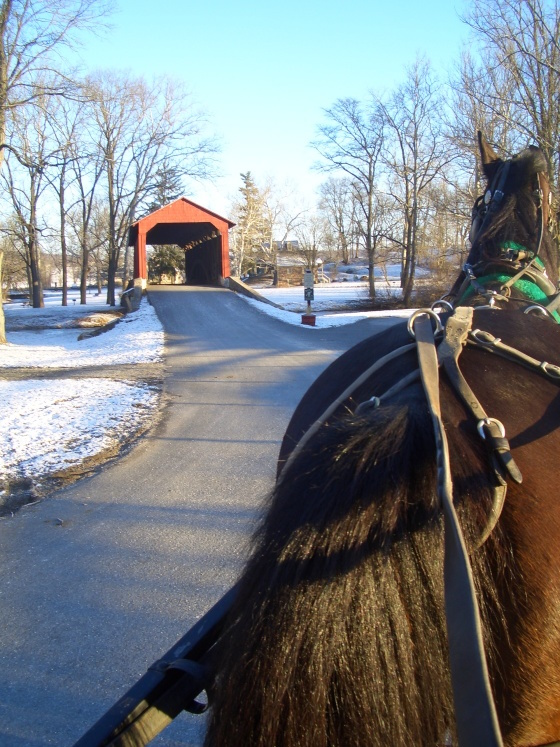
Truth be told, it’s hard for us to imagine relying on a buggy to get around everyday. And to be frank, not even all Amish do so. Many Amish hire “Amish taxis”, vehicles driven by English people, to travel to the store or more distant places. Amish business owners often keep at least one English employee on payroll to serve as a driver.
In some communities the tractor has taken on a prominent role. Some Amish use the farm implement liberally, even permitting it to be driven for non-farm tasks. These include going to town or to tow a wagon full of family and friends on an evening pleasure ride.
However, even those Amish groups who have become more liberal about using the tractor and other forms of transport, have held on to the horse-drawn carriage to some degree, realizing the symbolic and cultural importance. As the minister noted above, Amish and the buggy are in some sense inseparable.
Other Amish buggy articles:
Amish SMV triangle controversy
Further resources:
If you’re looking for a book, the best one on the Amish buggy is Plain Buggies: Amish, Mennonite, and Brethren Horse-Drawn Transportation, by Stephen Scott.





Neat!
Great article! The Mercer County buggy is also used by the Amish in Crawford County, PA. It was great seeing all the different varieties! I’ve noticed how fancy the Lancaster buggies are compared to the more humble buggies of Atlantic, PA- windshields, rear view mirrors, not to mention some sort of contraption that I can only guess keeps the horse’s waste off the roads.
Crawford County Amish
Thanks Amanda! I really wanted to get to Crawford County PA this past trip, but it was just a little out of range. Crawford apparently has the most individual Amish settlements of any county–seven, or at least it did a few years ago.
And you are right, buggies in some of these communities start to look a bit fancy. Something about the wheel guards in northern Indiana (picture above) make it look not like an Amish buggy, in my opinion.
The lighting on some of these buggies is incredible too, I wish I got a better photo.
Question about buggies
I’m curious — what might a basic family buggy in, say, Lancaster County cost? I’ve often wondered. I realize that it can vary widely, but you could definitely help me out with this bit of trivia. I’m really enjoying your articles and photos, too. Thanks for all the work you put into your website!
Price of an Amish buggy
Thank you Laura–buggy cost varies by the style and features, but when I went along with an Amish friend to order a new buggy last year, it was close to $8000. $7000-8000 range seems pretty standard in Lancaster. There are a number of add-ons you can get which affect the price.
Plainer buggies in other communities wouldn’t be so much. There would be fewer features available and a simpler construction (ie no storm fronts in some settlements, basic lighting, etc.)
Wow, a good buggy is as much as a good used car — and if you add in the horse and all its attendant costs, you’re not really saving any money by traveling plain, are you? Although I realize that’s not the reason.
On a related subject, thanks to recommendations I’ve seen here for various books, I’ve gotten a couple of the most recommended scholarly-type books on the Amish to learn about them on a more factual basis. I find minority cultures fascinating, especially ones who live a life as different and challenging from mainstream American life as the Amish. Thanks for helping me to fight my own ignorance! And I am VERY jealous of all the food you talk about all the time….we used to live very close to an Amish market (outside DC), so we had a chance to sample some of the homemade goodies. We’ve moved 50 miles away, but still make occasional trips back to pick up things like the jams and jellies — once you taste Amish-made food, it’s hard to go back to the mass manufactured stuff, isn’t it?
I agree Laura–the key is to take a small haul with you when you leave…won’t last forever but you can ration. I’ve got about 10 jars of spreads and canned goods to tide me over for awhile 🙂
This might have been my favorite post – this was GREAT!! I was just in Daviess County, IN, and took a bunch of pics inside a buggy shop – but they were kind of boring because it was like looking at skeletons and you’ve got lots of pics of the finished product. Good job!
Thanks Beth–these big ones take a LOT longer, but I think they’re worth it. I’ve got a few more in the works.
Some people like to see the process as well so your Daviess County buggy pics might not be as boring as you think!
I enjoyed this post very much!
Excellent post Erik and for me one of my most favorites from you. I really like the buggy styles from the state of Indiana as shown in your story. I have never seen an Amish buggy with fenders before so I’m really liking that one a lot. I kind of wish our Amish over my way would use rubber lined wheels because it may be a little more gentle on our roads, plus like you said provide a quieter ride for the Amish as well. Richard from http://www.Amishstorys.com
Buggy wheel covers
Richard the wheel covers (guards? fenders?) were not common even in Elkhart County–I only saw 3 or 4 buggies with them the whole time I was there (though I doubt that was all). They definitely give the buggy a different look.
Amish buggies
Wonderful pictures, I so enjoyed looking at them, learned a lot too. Thanks
Buggy vanity plate
Thank you Judy, my favorite photo is probably the one with the dolphin “license” plate–this was taken in Ohio, where buggies don’t carry plates, but the family had actually just moved from Indiana, where they do…not that you’d see a lot of buggies with this type of plate even in Indiana!
Amish Buggy
Great post and photos, Erik! I have read Stephen Scott’s book and it is excellent on this subject. I am interested in the buggy shop and plan the next time I return home to Illinois and visit the Arthur area on perhaps visiting a shop or two. This is my first time commenting but have followed this site for awhile…great work.
Old buggy shops
Greg, I appreciate you sharing, feel free anytime. You’re sure to find a few buggy places in Arthur.
What’s interesting is that carriage makers can be some of the oldest Amish businesses–before the “Amish business revolution” of the past few decades, someone had to have a shop to make the buggies. So these would have been some of the only Amish businesses while most Amish were still on the farm. In Lancaster County I believe there is one that is in the 80-90 year old range.
Interesting post! I’d thought it would be cool to run into you sometime while you were here in northern IN, but it didn’t happen. Of possible interest to you- my uncle Dan founded a “buggy shop” many years ago, northeast of Topeka (D.A.Hochstetler & Sons) many years ago. In fact my Dad worked for them for 20-25 years. At one time making deliveries for them, and also in the shop. They make mostly farm equipment these day, I believe. Uncle Dan passed away in March, at age 94, but sons, Ivan & Albert are running the business.
Buggy shops Elkhart-Lagrange
Mary that would have been fun–I actually bumped into a couple of people who knew me from the blog–that was a nice surprise!
Thanks for sharing about the DA Hochstetler shop, neat to hear that is your family. Just curious, do you have a sense of how many buggy shops there are in northern Indiana?
Sorry, Erik. I really have no idea. Sometime when I talk to one of my cousins I’ll ask them.
Amish Buggies
Thanks, Erik, great post!
My buggy looked just like the Hardin Co buggies except without the reflector bar. It cost me $2000 in the yr 2000. I am 6’1″ tall, so the buggy maker made the top 4″ higher than normal. I later had the top buggy box exchanged for an open top type buggy box when I left the Amish. The wheels and chassis remained the same. The people that got the top were the shortest in the community, so they have plenty of head room. I later sold the buggy to an Amish convert who put lights, decals, and reflectors all over it. Yuck. That convert was a little crazy. He drove that buggy into downtown Fort Wayne, IN (population 275,000), also to a community 55 miles away in MI. The buggy was moved to VA and very soon will be in southern OH.
Buggy speed is about the same as bicycle speed. At that speed you see all the flowers, birds, trees, and other sites that car speed does not allow or diminishes. Sometimes you get things you don’t want. One horse was a little dangerous to be behind. If he lifted his tail, he was going to pass gas, but there often were solids too, and at high speed. I was glad for the 4″ brim on my hat as it made a great shield :-O Oh, close your mouth, real quick too! It was possible for women(and girls) to get a real bee in their real bonnet!
Steel wheel buggies are very LOUD, especially on fresh chip-seal. In addition to the wheels, the wood frame and plastic canvas covering it act like a drum to make it even louder. You generally have to yell at the person sitting right next to you just to be heard. I would like to ride in a rubber wheeled buggy someday.
In the community I was in, the buggy builder’s oldest son is just starting up a buggy wheel making shop. Apparently the demand for wheels is so great, there is now a 6 month wait to get new or replacements for broken wheels. So, this just married young man is going to try to setup shop building wheels. I wish him well, he is a great kid and his new family needs him to succeed.
@ Lance, thanks for the comment. I enjoyed reading it and learning.o-: Lissa
Hi Lance. I read your post on buggies to my son, Mark. He said from your description that he knows who the convert was that you sold your buggy to. His initials are C.P.
I guessed the same thing. 🙂
Wow! I learned so much. Thank you for your post and all the pictures. I really enjoyed seeing all the different types of buggies. I always wondered what the church buggy looked like. Lissa
Amish Buggy
Erik:
After following the Amish blog for awhile, thought I would participate.
Thank-you Erik for the great informative and varied article on Amish buggies. In my possession I have an Amish buggy and horse. The buggy needs alittle work but the Minnesota horse is awesome. I recently approached our township board to post two buggy signs along our busy country road. Safety is always my main concern.
I am proud of my Mennonite heritage from Lancaster County, PA.
I have come full circle with my roots. No wonder I enjoy my horse and buggy,painting barn quilts,and the Amish American blog.
Erik, you are so fortunate and blessed to be a part of the Amish life.
Installing a buggy sign
Wow Linda, thanks for your kind comments and for sharing with us–I’ll be curious to see if you get the signs up, I’ve always assumed it would take a full Amish or Mennonite settlement to get a local gov’t to do that–but maybe your horse-and-buggy will inspire your neighbors to get one too 🙂
The Amish family we know are buggy makers. He started as a wheelwright and then his business expanded. What suprised me was that the floor system was fiberglass, while the rest of the buggy was wood. That was allowed in his district, and as he said it holds up better to the weather. Once he has all the electrical wired then his wife does all the upholstery. It is truly a family business.
Nice example Kevin, I tried to sing the praises of some of these Amish wives in Success Made Simple, they often play a pretty big role. And when you ask Amish men about their wives they tend to give them credit (or at least they oughtta!)
In large Amish settlements where everyone is of the same affiliation and has the same style buggy, are Amish people ever
not able to find their buggy at a large Amish event such as
a benefit auction? Do they ever forget where they parked their
buggy (like we English sometimes forget where we parked our
car at the shopping center lot)?
I had an interesting experience lately. I went to one of the
Amish farms where I regularly buy produce. I needed to talk
with the man of the household, but he was not yet home from a
neighbors. As his wife and I were standing in the yard waiting
for him, I saw a buggy coming down the road about 1/4 mile
away, and I said, “Oh, this must be him coming now.” She paused
a minute and said, “No, that’s not the sound of our horse, so it’s
not him.” A few minutes later, she said, “I hear our horse now,
so my husband will be home soon.” I thought it was so
interesting that this woman identifed their buggy by the sound of their horse trotting on the road.
I never lost my buggy once, even in a very large group of them. Every buggy has something slightly different about it. You just need to remember what the buggy you came in looks like. Also, you learn right from the start to remember where you put your buggy. Helps if no young folks are playing tricks that day. Happens.
I remember visiting Old Order County in Ontario and seeing kids peering back at us through rather larger back windows than the ones shown here. I think its possible they where just as curious about the unfamiliar vehicles and people inside as we were about them, either that or they were playing and making fun, but no one would know.
I kind of feel for the horse that has to look at the dull gray cement wall while the owners are in doing whatever, I know its just an animal, but that has to be a dull thing for the handsome beast to have to stand in front of.
Erik you did a tremendous job on this entry, as everyone has said. You’ve outdone yourself this time!
What do buggy horses do while waiting?
Shom I’ve always wondered what goes through the horse’s mind as he patiently wait. I mean, once you’ve eaten all the food/drunk all the water, what can you do besides stomp your hooves, snort and pick at the grass? 🙂
In the Adams County auction photo above, you can see some of the horses which had been tied to a wagon with some horse eats scattered about on top. There were a couple dozen horses around it, I can imagine the conversation they must have been having, “bid on the thing already Schwartz, it’s time to hit it for home!”
DON'T UNDER STAND
I DON’T UNDERSTAND AND HAVE TALKED TO SEVERAL AMISH ABOUT THIS THEY DON’T HAVE A GOOD ANSWER EITHER THAT IS JUST THE WAY IT IS. WHY CAN THEY RIDE IN A CAR TRUCK ECT. BUT IT IS WRONG TO OWN ONE??? THEY ARE PAYING TO RIDE IN THAT CAR TRUCK ECT. BECAUSE IT WILL GET THEM ANYWHERE FASTER!!!! BUT THAT IS THE REASON YOU GAVE THAT CAN NOT OWN A CAR. I LIVE IN THE MIDDLE OF ELKHART CO. AMISH EVERY WHERE AROUND HERE. THE SAME WITH PHONES AND NOW THEY ARE EVEN MORE APART OF ALL OF US WITH THERE CELL PHONES AND MANY MANY HAVE THEM. IF NOT A CELL A HUT WITH THERE EXT.# SO THEY GET MESSAGES JUST BECAUSE IT IS IN A SHED AND NOT IN THE HOUSE THEY THINK THEY ARE STAYING AWAY FROM THE WORLD WAYS BUT THEY ARE NOT. THEY ARE JUST TRYING TO LOOK ONE WAY BUT ARE LIKE THE REST OF US. HAVING IT IN A SHEAD OR CELL IN MAKES NO SENCE EITHER IT IS WRONG OR IT IS NOT WRONG!!!!
Why don't Amish drive cars?
Sue, it is part practical and part symbolic. There is still an important distance there when you have to rely on an Amish taxi vs. having a personal car you can use at any time.
With a taxi you have to arrange the ride in advance (there might not be anyone available if you don’t plan ahead), depend on the driver’s schedule (who could also be late) and pay high rates for it, which tends to discourage using it too much. Quite different from the American freedom concept of jumping in the car, hitting the open road and leaving your cares behind.
The car is not evil according to Amish–but having one sitting in your driveway that you could take for a spin anytime would inevitably lead to more trips and time away from home.
Amish feel this would weaken their families and communities. Some would tell you that outright, some would know it instinctively, and others probably wouldn’t give it a lot of thought, just being the way things are done. A car is also symbolic of the world, and Amish generally try to keep the world at arm’s length (though as you note with the cell phone, that is not always so easy).
Amish people do have to travel long distances–for work or to visit family–so hiring an Amish taxi is a practical solution to that problem that still prevents the car from taking over their lives.
Some Amish surely use it more than others, and for the wealthier business folks the cost is not the discouraging factor it is for others in their commmunity. No doubt some Amish frown on “over-use” of the car. There are some Amish that don’t even allow hiring a car for these purposes, but most do.
Cell phone and shed
The cell phone is more controversial. More and more Amish have been getting one. Some are good about switching it off after business hours or keeping it physically segregated (in a driver’s car or out of the home). But it’s definitely of concern. It fits in your pocket and it’s not like the car where it is obvious if someone owns one.
With the phone shanty, it is a similar concept as the car above–inconvenience encourages you to use it less. And not having it in the home keeps the “world” from invading and disturbing family life (how many teens spend a ton of time texting or on the phone, not to mention other members of the family). However the phone shanty seems to keep creeping physically closer and closer to the home in some communities, and rather than a number of families sharing one, as is the case in some places, homes are getting personal phone sheds.
Sadly, just learned of a pony cart accident which happened yesterday (Labor Day Mon) in northern Indiana. 2 children were killed:
http://www.reuters.com/article/2011/09/06/us-ponycart-death-indiana-idUSTRE7844B920110906?feedType=RSS&feedName=domesticNews
Wheelwrights in Pennsylvania
I’m a traditional English wheelwright and Yeoman of the Worshipful Company of Wheelwrights of London, England. I’ve wanted to come over and visit the Amish Communities for some time and often wondered what opportunities there might be to establish a small business building, repairing or restoring carriages and wheels in Pennsylvania, particularly around the New Castle area, near Pittsburgh
Erick,
My nephew just called me a bit ago and told me to do an image search on Google for Hicksville, OH, and said I would find a picture of his buggy. He was right, and I followed the link to your interesting blog post…then, coincidentally enough, I scrolled down to find another familiar scene…the auction picture in Adams County was taken at my brother-in-law’s auction! 🙂
LED lights for Amish buggy
I read the buggy cost around 8,000 with option for assessories. Is LED lights available? I manufacture LED lights and is looking for people to work with. Regards, Johnson
Mr. Johnson,
LED are widely used among the Amish. I might be able to help you with your marketing to them. Feel free to send me an email at wayn.swiss@gmail.com.
This was a great article. I was raised by my grandparents
& although they weren’t Amish I used to wonder why my
grandmother would always wear long dresses & skirts with
a bonnet. And both grandparents were extremely
“STRICT” & lived by the bible (totally). It’s hard to
find honest, hard working folks today. Thanks for a
great article.
Horse transport is natural!
Like composting, recycling, bicycling, modest use of resources, re-use and organic food – it’s good for you, your family, community and the world!
No need for wars for fuel security… no air pollution… no senseless noisy zipping through other people’s places… no barrier and obstacles to non-motorised traffic and animals in town and country…
I live by an Amish community, located near Wilton, Wisconsin. I give them rides when they need it, they use my phone. Their children would come by one afternoon to play on my trampoline (even their father had fun too!!)The Amish are very friendly people. They always come by and drop off a variety of produce and bakery items. The Amish are quiet people, but once they get to know you, they treat you like you are part of the family. Always respect the way they do things, it is different then what we are used to but they are happy people..
Where can i find a Wheelwright in amish country,PA
I am from nova scotia, canada and am restoring several old buggies. I will be travelling through PA around the 12/13 of March 2014 and was wanting to know of any wheelwrights so I can purchase several wheels
My e-mail address is hossmackenzie@hotmail.com
thank you for you help
Hoss
purchase a Amish Buggy?
Would like to purchase a used Amish Buggy?
Randy, there are probably folks on here that can give you better answers than I can, but I do know that there is a *huge* auction in Jamesport, MO, every year, and it includes a number of buggies. There are acres and acres of stuff, with some four or more auctions going on at the same time. It’s supposed to be a major draw, with Amish coming in from even out of state (so I’m told). And plenty of non-Amish there as well, so it’s not like you or I would stand out.
If you’re interested in getting a ‘feel’ of how big the auction is, this link will show you one of three batches of pictures that I took while there last summer. Down in the middle of the set you’ll see some of the buggies lined up for auction.
https://www.flickr.com/photos/ozarkinspirations/sets/72157634758533522/
Reply to Don Burke
Thank you Don. This is some thing I should check into.
More suggestions welcome!
You are welcome. I should have mentioned that the auction is usually the first week of July (although I have not been able to find a date for this year’s auction yet).
Custom Woodworking
I have been referred to this site my a fellow Long Beach Model T Ford Club member. I am currently repairing/restoring the two man top of a 1922 Model T Ford Touring Car. The bows that are held in irons that support the top fabric and pads have deteriorated and may need to be replaced. The two end pieces on each of the four iron assemblies are a curved piece of wood (oak or other suitable hardwood) at a 90 degree bend that are either steamed and bent or constructed by gluing thin laminations at the proper curve while holding them at the proper curve while the glue sets. I believe the radius of the curve of the bend is approximately 3 ½ inches. The bent section should be approximately 2 inches wide and 10 to 12 inches in length. I will have to do the final finishing and sizing to the total of 8 curved/bent pieces into the steel irons and an upholster specialist will attached the pads and top fabric along with the supporting straps/webbing tacks and upholstery nails. I was wondering if you could recommend several of your woodworking craftsmen capable of doing this small job and what the approximate total cost would be. I can be much more precise with the specification/measurements and send photos of the current woodwork if needed I think this may be similar woodworking that is done when repairing or constructing Amish buggies. Thank you in advance for your effort.
Amish - Vehicle Restoration
Mr. Apthorpe:
If you scroll back on this site to the entry of 19 November 2013, there is an article about an Amish company that specializes in the restoration of old vehicles (including motor vehicles). I’m pretty sure they have woodworkers and upholsterers.
Specifically in the article, the firm was in the process of toally restoring a Stanley Steamer. I believe they might be able to be of assistance:
“Double E Carriages”, 40 North Harvest Rd., Bird-in-Hand PA 17505; phone [717] 768-8484
If you telephone you might reach an answering machine; leave a message and they will surely get back to you.
Carriage Shop
Good memory, City Slicker. If anyone has trouble finding the post you mentioned, here’s the link:
https://amishamerica.com/the-things-you-find-in-amish-carriage-shops/
Model T Ford Top Bow wood restaration
Dear City Slicker-
Thank you for the quick reply to my query regarding the availability of craftsmen to fabricate replacement shaped/curved bow parts for the top irons of my 1922 Model T ford Touring car. I will contact the referrals ASAP.
Thanks again.
John R. Apthorpe, MD
the Amish buggy
I have been reading your articles/blogs for some time and you mention a lot of communities in various States, but I have yet to see you mention ours here in southern Maryland….one of the oldest Old Order Amish settlements…Mechanicsville and Charlotte Hall.
Articles on the Amish in St. Mary's County, MD
Catherine we actually do already have a couple of articles on that community.
https://amishamerica.com/the-amish-of-mechanicsville-maryland/
https://amishamerica.com/maryland-amish/#stmarys
We probably have some other mentions of the community on other posts over the years; if you use the search box at the top of the page you should be able to find those.
I had a chance to visit this settlement in 2010 and enjoyed it. The community was started in the 1940s by Amish from Lancaster County. I liked the bilingual signs that Amish use there to advertise their goods in both English and Spanish (“Fresca Queso”; “Gallinas”).
The Amish Buggy
Thank you. Your quick response is always appreciated. I will enjoy looking those up. I am interested in knowing how you were received by the Amish here? For the most part they are not as quick to talk to the “English” and Tourists as say the ones in Lancaster, for example.
Safe travels.
Good observation, I was only there one day, I believe this community is generally considered to be more conservative than the average Amish in Lancaster, at least those on the north end. Amish originally came here in the 40s in response to threats to parochial schooling.
I did have a couple of nice conversations with people who seemed pretty friendly towards me, one in a woodworking place and another at a dry goods shop. I don’t think this community gets that many tourists either though, does it?
Great article! Was curious, have you ever encountered Amish people who call it a “carriage”? I read a novel about the Amish by a very popular author – not something I normally read fiction about – and noticed she used the word carriage interchangeably with buggy. I have never heard that term used by my Amish friends, but maybe it’s because they’re from Illinois & Indiana? The novel took place in Lancaster, PA, if I remember right. So maybe it’s something that happens some places but not others?
I want to say yes and that may actually even be more common in some places, but I’m relying on my sketchy memory, as I hadn’t paid close attention to that English language detail. Perhaps someone else can confirm/refute.
In most PA Amish communities, the covered vehicle is called a carriage and a buggy is used for a one-seat open vehicle. In western communities (OH, IN, IA, WI, etc.) a buggy is a one-seat covered vehicle and a one-seat open vehicle is an open buggy. Two seated covered vehicles are usually called a surrey and an open two-seat vehicle is an open-surrey. Sound confusing? That doesn’t get into all the other vehicles like hacks, springwagons, top-hacks, cab-wagons, market-wagons, etc.! 🙂
In PA a business making or repairing vehicle is usually called a coach-shop or carriage-shop. In western communities it will be called a buggy-shop.
Thank you!
That wasn’t confusing at all. My friends are in the Midwest. I think I’ve heard them refer to it as anything other than a buggy only once, and that was -possibly- a surrey. So when you say “one seat” and “two seat,” you mean a bench or row? When I was little, and I lived near that family, they had a buggy with two rows… at least (I guess there’s no such thing as one that goes deeper than that; it probably just felt huge because I was 3 years old!). It would’ve been able to seat… four adults, I’d say? So is that what you mean by a “two-seat”?
Hi Jan. Yes, one buggy seat can easily seat two adults. (Three if they know each other well – ha.) A surrey with two seats easily sits 4 adults.
That must have been it, then. Thanks, Mark, I really appreciate you sharing your expertise! 🙂
You’re welcome.
Mark's buggies
I asked Mark about his buggies. He says that around Belle Center they are referred to as “gaul und bouggies”. The u in buggy is pronounced as you would the ou in double. Mark has a single-top buggy, a mini-surrey, an open buggy, a two seated spring wagon, a cab hack, and a road cart. As you can tell, Mark likes to collect carriages. Some of the Amish kid him and say he’s going to need to add a ssecond floor to his barn with a ramp like in parking garages if he wants to add any additional buggies.
Mark's buggies
When I was referring to Mark and his buggies I was referring to my son, Mark, of Belle Center, Ohio. Not the Mark of Holmes County. Sorry.
Ha! Very interesting, thank you for sharing! That’s funny about adding a second storey to the barn. 🙂
Buggy
In my area it’s like this:
Cart – the two wheel open surry. Ponies are often the driving force. All road horses should be trained and are most always tested with carts.
Buggy – closed top four wheel vehicles with usually one horse but sometimes two. I’ve have seen them with wagons (like a large kids wagon) attached and trailing behind.
Carriage – open top “buck board” type. Also called a market carriage.
Farm wagon – four wheeled and pulled by a team of work horses. Once I saw a covered wagon (Conestoga type) in Lancaster county.
I’ve heard these terms used by Amish and OOM in Synder and Dauphin counties at seasonal mud sales. I’m a bit of a buggy nut and I can study one for up to 30 minutes looking for different details. My father and grandfather made many horse-drawn vehicles in the 1930’s and 30 years there after.
It seems that it differs from place to place much like the Amish themselves.
That’s really cool, Jerry, thank you for sharing!
Jerry, if you are ever in Holmes Co. you’d have lots of details to look at. There are several Amish groups here and each group has its own way of making buggies. Winesburg Carriage Shop is an interesting place for “buggy nuts” and on the top floor of the three story building there is a collection of old buggies & surreys — not just Amish — from all over. You’d probably enjoy that!
Horses
Hey Erik – I saw this interesting article about an Amish Horse Buyer in Modern Farmer….
http://modernfarmer.com/2013/06/racehorses-amish-buggy/
It was out a few years ago, but might be an interesting post. I would love to know more about the horses of the Amish.
Just a thought…
Hi Judith. Was there anything in particular you were interested in? (about horses)
SEEKING: DRAFT-size Wooden-wheel Cart
New friends,
I’m in San Antonio, TX & looking for a good-condition “old school” DRAFT-size cart for the local trail-rides.
(The Amish gentleman, who used to build my carts, has sadly passed away & his family has left TX.)
yours, tex
Lancaster Amish buggies
These buggies look really small. How many people can sit in them? What do they do to carry more people?
Thanks!
parts?
We purchased a home that has an Amish buggy parked out front. We are hoping to get the lights working again, and are having a hard time finding replacement bulbs. Any suggestions on where to find/order bulbs or other parts we may need to keep it from falling apart?
Thanks!
The Amish buggy
Take the light bulbs to an auto parts store they should have the correct bulb.
Marcus Yoder
Can't wait to drive my Market Wagon
Thanks for the article. I bought a brand new Market Wagon from Paul Raber of Indiana! He is renowned for his buggies and wheels. It’s gorgeous. Just trying to find a new buggy horse to drive it. My old mare died at 31. Drove her around this valley for 17 years! I swear by Amish buggies and trained horses! Greetings from Paonia, Colorado!